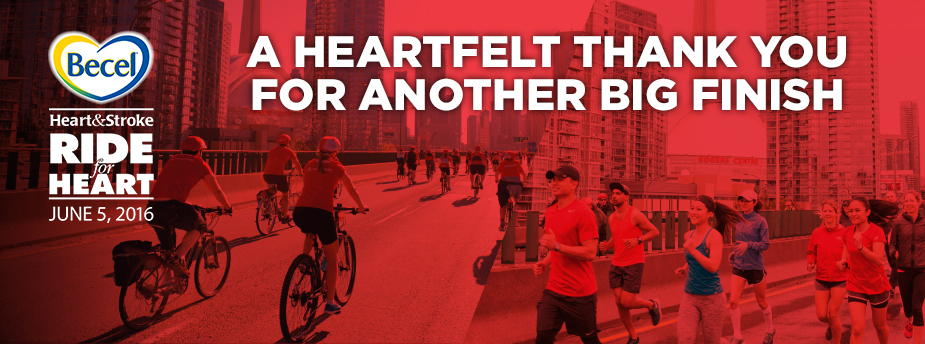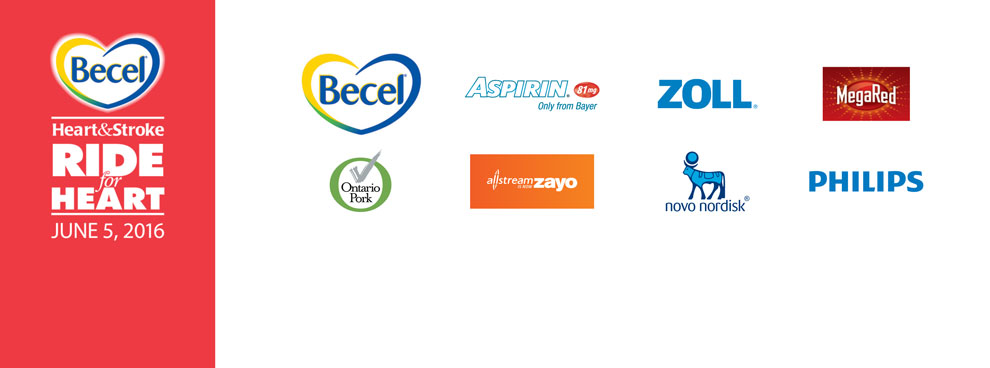For Captains
As Team Captain, you will have the unique pleasure of guiding your team members through the Ride for Heart experience from start-to-finish. This is not for the faint of
heart! But considering that our Team Captains come back year after year and have a fundraising average above $1,200, it would seem that they all find the experience rewarding,
challenging, engaging, and enjoyable. At least, that’s our goal for you!
To make it all those things and more, follow these simple steps for Team Captain Success:
Recruit your team
Recruiting cyclists, runners and walkers will be the easy part of your job because this event sells itself. A traffic-free ride or run along the Gardiner and DVP is
something people can’t wait to experience. And the Heart & Stroke Foundation is a well-known name serving a need that impacts everyone. So you won’t have any
problems filling spots on your team!
What you will want to consider, however, is the right size of team, the right mix of cyclists, runners and walkers, and the
fundraising expectations for each individual.
Fundraise
Don't sweat. Fundraising is not as scary or as difficult as you may have heard. As Team Captain, you’ll lead your team through the mire with confidence as long as you follow our expert advice! There are a few tried-and-true formulas and techniques you can implement that will ensure fundraising success.
It's tempting to leave this up to the fundraising gods, but you have the control and ability to set a challenging goal while still being realistic about your team’s unique abilities. There’s actually a science you can use to set just the right goal that will be inspiring, challenging, and rewarding when you complete it:
- VIPs - Recruit “heavy-hitters” who can fundraise $1000+
VIPs (Very Important Philanthropists) can be experienced fundraisers, people with strong networks, or people with a personal connection to the Heart & Stroke Foundation. They can really change the fundraising experience for the team. - Strength in numbers - Recruit a large team of 40+ fundraisers
If your company can host a large team, go for it. Each team member represents a minimum of $100 in fundraising so you can estimate a baseline team goal by multiplying the number of team members by the fundraising expectation per person. - Suppliers and vendors are key - this is a perfect opportunity for them to give back
If your company does regular business with any suppliers or vendors or, if your company is the long-term client of a firm or agency this is a perfect opportunity to ask them for a donation. They will see it as a valuable opportunity for relationship-building. Don’t leave this stone unturned; it’s the #1 Best Practice of our top fundraising teams! - Plan team events - they boost your team total, raise your profile, and build team spirit
Plan at least two group fundraising activities. They can be as simple as a bake sale, book sale, or jeans day. Or you can do something a little more exciting, like asking your CEO to participate in a challenge to drive fundraising. On average, team events raise about $200 per event. - Ask for a match - if you don’t ask, you don’t get
If your company does not match employee donations, ask for a corporate contribution to the team total. If you need any support for this request, such as a letter from the Foundation, please reach out to corporatechallenge@hsf.on.ca.
Mix and match this five elements to create the fundraising goal that works best for your team. Be creative, driven, ambitious and ultimately realistic about what you can do together to create more survivors.
Plan your communications out in advance so that you don’t have to suddenly fit it in to an otherwise busy schedule. Put reminders in your calendar one every four or five weeks or so until Ride day that will remind you to check in with your team members and their fundraising progress.
It will boost your own profile as well, and who doesn’t enjoy some personal credit?
You should also consider scheduling a kick-off presentation, in person or online, so that your team members can take full advantage of our Ride for Heart expertise. Contact the Corporate Challenge to find out more and schedule your presentation.








